Art & Exhibitions
Christopher Roth Creates Antonioni Tribute Featuring Veruschka at Esther Schipper Gallery
With his dense work, Roth raises uneasy questions about the future.
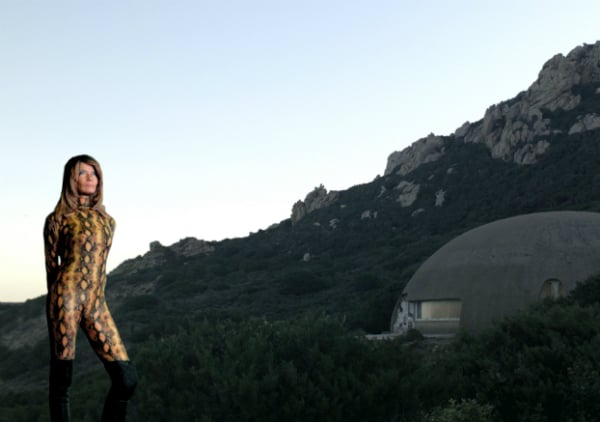
With his dense work, Roth raises uneasy questions about the future.

Hili Perlson

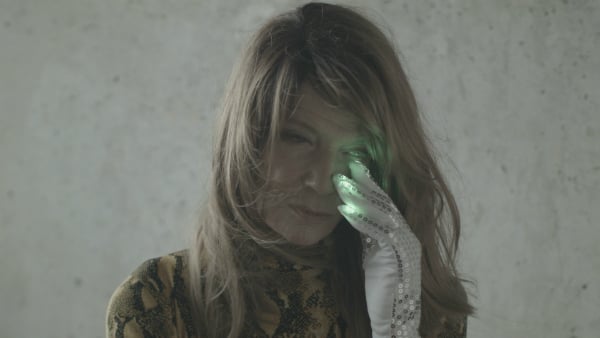
Christopher Roth, film still from the film Blow Out (2015).
Photo: Courtesy Esther Schipper, Berlin.
“I thought that our present time, which was the future back in the 1960s, would be a lot wilder,” German artist and filmmaker Christopher Roth tells me as we walk through his exhibition “Blow Out” at Berlin’s Esther Schipper Gallery. “We still construct buildings that look like they were made in the 19th century. What ever happened to Metropolis?”
It has been noted before that our aesthetic notions of the future are moored in concepts imagined in the past. Roth’s show centers on a video, also titled Blow Out, that speaks of a nostalgia for the exciting promise of the future—and the sober withdrawal from such folly that is our lot today.
Roth’s minimal yet rich exhibition weaves a dense web, starting with its title: “Blow Out” immediately brings to mind the 1966 film Blow Up by director Michelangelo Antonioni. But it also refers to the construction technique used to build Binishells—a round concrete structure shaped by blowing out a huge air balloon—invented by architect Dante Bini.
Bini built such a structure for Antonioni and his then-lover, the actress Monica Vitti, on the Sardinian coast. Completed in 1972, the house has never been lived in as the couple soon split up, and it was left to deteriorate ever since. Roth shot on location inside this ghostly concrete half-sphere, where even the furniture still stands untouched, slowly wasting away.
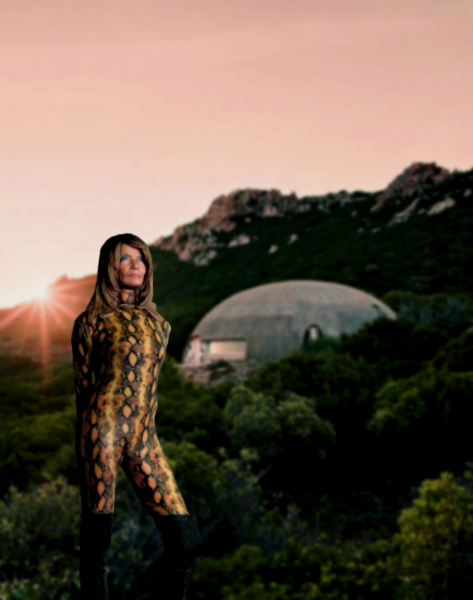
Christopher Roth, film still from the film Blow Out (2105).
Photo: Courtesy Esther Schipper, Berlin.
The film addresses Antonioni directly; the words “Dear Antonioni…” appear on the screen in bold letters, as messages such as “They’ve built the hoverboard from Back to the Future” flicker on and off. Veruschka, a persona created in the 1960s by German ur-top-model Vera von Lehndorff, pops up as a 3D-printed figurine placed around the house, only to disappear quickly and be replaced by a flashing green-screen cutout of her silhouette.
Here, too, Roth blends fact and artifact. Veruschka played a fashion model in Antonioni’s Blow Up, and her 3D scan was done with her wearing the same snake-print catsuit and knee-high suede boots she had worn in the film. Her only line in this short but memorable appearance in cinema history—”I am in Paris”—shows up on the screen in the video; it also hangs on the opposite gallery wall rendered in brightly colored neon lights in a font reminiscent of kitschy tourist totes, where the “A” in Paris is sketched in the shape of the Eiffel Tower.
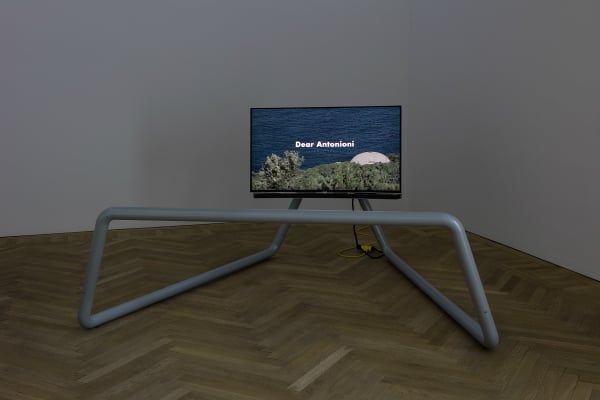
Christopher Roth, Pilgrim Viewer (2015) A specially constructed viewing device in collaboration with Sam Chermayeff and Arno Brandlhuber.
Photo: © Andrea Rossetti, Courtesy Esther Schipper.
And so the web of connections thickens as the non-linear plot spins around its own repetitions. We see the legs of a women clad in a micro-mini skirt climbing up the stairs in a sexually suggestive shot that repeats throughout, a reversal of the movement of Duchamp’s Nude Descending a Staircase. There’s a voice-over reading Antonioni’s letter to Bini, who had pressed the reluctant architect to add those stairs to the original purist structure so that he could sit back and watch his lover as she walks up and down.
Black-and-white footage of an interview with the young Monica Vitti blends in; we see another attractive blonde looking on, moodily, from the house’s balcony. If this performing of tropes from post-war cinema doesn’t drive home the point about women’s narrow representation on the big screen in that era, then von Lehndorff’s casting of herself as a neat little 3D printed object certainly does.
The 3D-printed miniature portrait, this technologically advanced gimmick, will sure make for a curious relic of our times at some distant point in the future. Has J.G. Ballard’s worst fear materialized? Is the future boring?
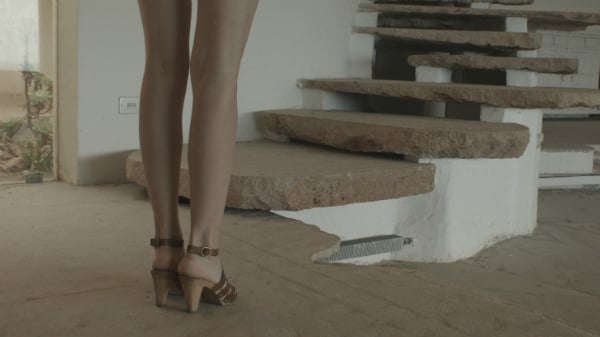
Christopher Roth, film still from the film Blow Out (2105)
Photo: courtesy Esther Schipper, Berlin
Roth’s oeuvre spans several mediums and his output is hard to pigeonhole: He is a respected filmmaker and has directed, among others, the biopic Baader (2002), about Red Army Faction leader Andreas Baader who operated mainly in West Germany during the 1970s. He’s a co-director of the new Tilda Swinton-produced film about John Berger, which premiered at the Berlin film festival last weekend, and is planning to approach the disturbing legacy of Otto Muehl’s Friedrichshof Commune in his next feature.
Roth is also the initiator and editor, together with writer George Diez, of the extensive project 80*81, which looked at the years 1980-81 as pivotal moments in history that saw the world’s cultural, political, and economic landscape change dramatically in ways that are still apparent today.
But perhaps Roth is best described as a film editor. And it’s with an expert editor’s eye that he ties in and switches between the film’s various elements, and conflates them with the objects in the exhibition. The gallery walls and even the ceiling are adorned with geometric green shapes. They trace the actual contours of the windows and skyline in the film’s Binishell. In the original technique of constructing Bini’s spheres, these openings were literally cut out from the walls after the structure had been raised by the balloon.
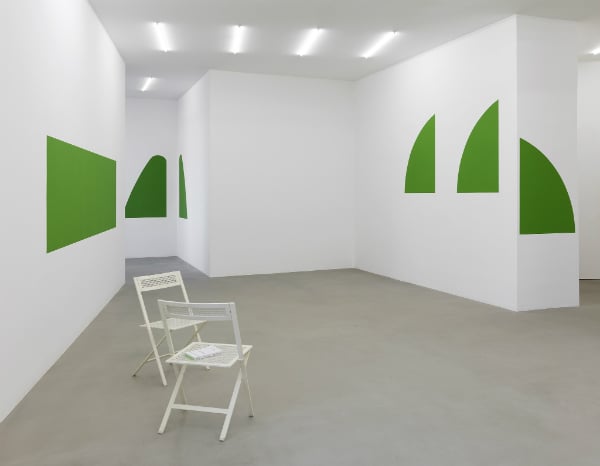
Christopher Roth, Installation view at Esther Schipper.
Photo: © Andrea Rossetti, Courtesy Esther Schipper.
Roth paints them in a bright green to repeat and transport the green screens that appear in the film unto the gallery space. (Funnily, they also look like slightly distorted Ellsworth Kelly works). There’s also a large green QR code painted on the wall, which opens a link to another film created by Roth and Veruschka.
Roth’s use of green screens alludes to the idea of hyperspace, a notion proposed by Fredric Jameson, who recently looked at the film Back to the Future to write about time-travel. Jameson suggests that the camera is akin to a time-traveling device with its ability to render us at once observer and observed. But has that helped us gain the diachronic distance we think of when we invoke time travel? “If we don’t have a future it means we don’t have a present,” Roth explains. “We need to be able to imagine the future in order to create and shape our now. It’s a very Ballardian thinking.”
Considering his preoccupation with probing our notions of the future, it should come as no surprise that Roth is keenly attuned to current philosophical discourses, such as Speculative Realism and Accelerationism, and the questions that the film tackles echo such thinking as: How can we speak about feminism, socialism, and so on without being recursive? Are we running the risk of leaving the future in the hands of big corporations? Are we unable to imagine and thus influence the course of what’s ahead? After all, Roth insists—quoting Slavoj Žižek—there is no return to a hippie utopia, there is no turning back.
“Christopher Roth, Blow Out Featuring Ver(uschk)a” is on view at Esther Schipper gallery from January 22 – February 27.